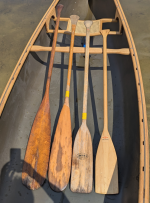Now I'm falling down this rabbit hole after 60 years of using whatever paddle was available... I guess finally getting my newly restored canoe in the water makes me want "nice things"...
As a recently retired engineer I tend to over-analyze everything. According to the Bending Branches chart and my 28" torso length, I should use a 54" paddle but that's too short... though they
do say to add 2-4" for a beavertail, which is what I want. But I think even 58" will be too short.
Yesterday I took four paddles out for my first ride in the new boat.

Starting from the left, #1 is a 66" paddle of unknown origin (I found it under our cabin when we moved in). 66" long with a 36" shaft. It looks a lot like the "Maine Guide Paddle" on the far right of the first post in
this thread. #2 is a 60" Shaw & Tenney borrowed from the camp's paddle barrel with about a 33" shaft, #3 is a 57" Feather also from the barrel, and #4 is a 54" Carlisle that I believe my daughter bought... with the same 36" shaft length as the 66" #1.
#3 & 4 I quickly dismissed as too short despite the chart's 54" recommendation... though maybe it was just too-small blades for the windy day. I think I'll retry #4 as a shallow water paddle (mostly I'm paddling in deep water, thus my preference for the beavertail). #1 was a bit too long, though manageable. #2 was perfect or maybe an inch too short when gauging in the boat from eye level too the water. But #1 was also much heavier than #2, I have no idea what kind of wood either are made with.
I plan to make a paddle or two from locally cut ash (same as I used for the canoe restoration). I like the shape of the long paddle and its grip feels perfect to my hand so I'm thinking I'll copy that, but with a 34" shaft and a slightly shorter blade for a total length of 62".

The longer paddle has a 1-1/16 diameter round shaft, while the shorter one is more oval, 1" x 1¼. I haven't decided which I prefer. Also the longer paddle has a slightly asymmetric blade; one side is flat while the other side is slightly convex, though it's subtle and hard to say whether it's intentional.
But realistically I probably won't get around to paddle making until next spring, though I'll probably start picking through the piles of ash for a good straight grained piece (there may be some black walnut left, too...). In the meanwhile, I need to keep my eyes open for a suitable reasonably priced paddle, new or used.


